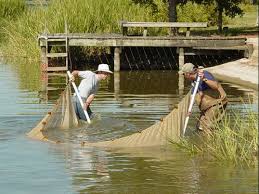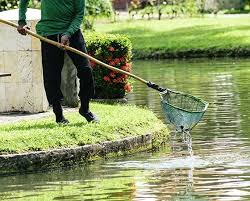Often, therapeutants are required to manage the disease and parasite problems which accompany or follow poor water quality periods. However, there exist certain guidelines (prophylactics) which can help to maintain sanity within the pond ecosystem if adhered to strictly thereby avoiding use of antibiotics.
Medicated feeds are commercially prepared catfish feeds which contain an antibiotic. Bacterial infections are controlled by antibiotics. The most common bacterial infections of catfish are Aeromonas sp., Flexibacter columnaris, and Edwardsiella ictaluri.
Only two antibiotics are available in medicated feeds for catfish. Terramycin contains the drug oxytetracycline. It is effective against all the organisms listed above, but is only approved for use against Aeromonas and Pseudomonas infections.
Feed against Aeromonas and Pseudomonas infections. Feed Terramycin for 10 days followed by a 21-day withdrawal period. It is only available in a sinking feed.
Romet is a potentiated sulfonamide which contains two drugs, sulfadimethoxine and ormetoprim. It is approved for use against Edwardsiella ictaluri infections and against Aeromonas infections which are not sensitive to Terramycin.
Romet does not appear to be effective against F. columnaris disease, therefore, is not recommended for use during F. columnaris outbreaks. Feed Romet for 5 days followed by a 3-day withdrawal period. It is available as a floating feed.
The final choice for an antibiotic should be based on a laboratory test called a sensitivity test. The test determines which antibiotic will work best to control the bacteria isolated from your fish.
A fish health professional can complete this test and recommend the best control of a bacterial disease outbreak on your facility. Keep in mind that bacterial diseases are usually a consequence of poor water quality, excessive parasitism or improper handling. These management problems must be corrected for successful, long-term control of infections.
Important Steps for Implementing Proactive Pond Management

• Prepare pond properly: Pond should be free of disease causing organisms and microbes before stocking. Organic debris accumulates on pond bottoms as a result of any catfish production.
Drying and stirring this debris helps to oxidize organic wastes and may help curtail chronic disease problems Therefore, proper pond preparation strategies as described in the previous unit should be employed in order to ensure security of the stock.
• Clean all farm items after use: All materials like scoop nets, plastic baths or buckets and sorting or counting bays, used must be disinfected washed immediately and allow drying properly and storing well before re-using.
This concerns all activities such assorting and grading of fish, cleaning of fish tanks, transferring of fish from tanks to another, counting for saleand slaughtering.
• Grade your fingerlings: Grading of fish at intervals helps to ensure collection of the same size of fish in the pond and effective feeding of the same size of feed pellet.
Small fingerlings have difficulty competing with large fingerlings for food throughout the growing season and as such some part of the feed are wasted in the water leading to poor water quality condition.
• Regulate stocking density: Use appropriate stocking density as much higher stocking rates may be difficult to management.
• Use high quality feed: Using a nutritionally complete, floating ration is an important component in proactive pond management. Feed must provide complete nutrition with maximum conversion efficiency. Extra protein is needed to ensure rapid growth without reducing water quality. Lower quality feeds often are less accepted by fish, have poorer conversion efficiency, which results in more waste products.
• Use reduced feeding rates: Catfish need adequate food for growth and health therefore, many commercial catfish producers feed their stock to satiation (all the feed the fish will eat) daily or use a feeding schedule based on estimated fish weight (3 – 5% of fish body weight
per day).
This may not work all the time as fish performance oractivity is affected by the weather in some situations and so may not eat all the feed that is given to them based on calculation.
• Feed the Fish and not the Water: Spread feed evenly. It is very important to scatter feed over as much of the pond as possible when using reduced feeding rates. Otherwise, aggressive, larger fish will “hog” the feed and reduce feed efficiency. If your feed application system is limited to a small area of the pond, divide the feed into two or more feeding passes.
Catfish will learn your feeding patterns, so occasionally reverse or alter your pattern, to provide an opportunity for all fish to obtain feed.
Read Also: How to Know Which Medicated Fish Feed to Use
Read Also: Efficient Solutions for Food Waste Disposal

